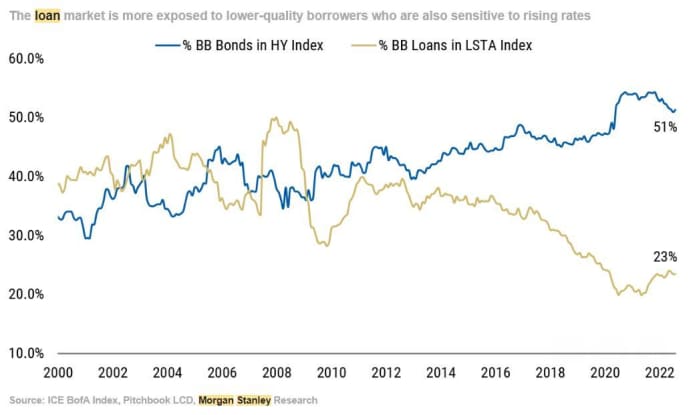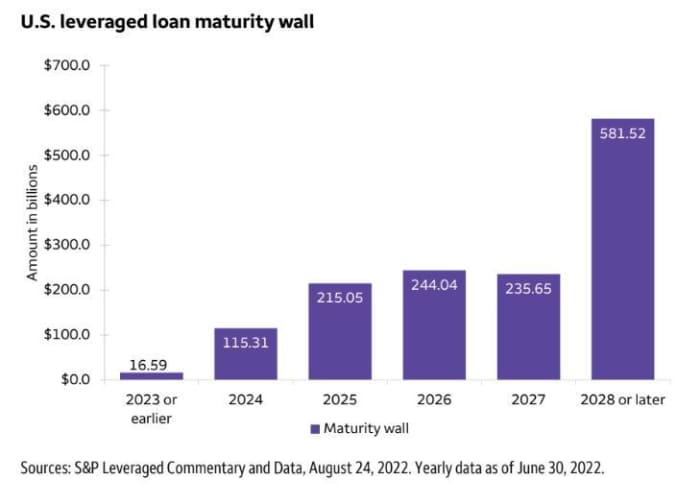Now that Federal Reserve Chairman Jerome Powell has made it abundantly clear that the Fed has no plans to slow the pace of interest-rate hikes, some bond-market experts are warning that the most speculative areas of the credit market might be in for a rude awakening.
A team at Morgan Stanley
MS,
warned that leveraged loans could be the “canary in the credit coal mine” due to their floating interest rates and the increasingly poor creditworthiness of issuers. As the U.S. economy slows, these borrowers can expect to be hit with a double whammy as cash flows deteriorate while debt-service costs rise.
For those who are unfamiliar with this corner of the credit market, the term “leveraged loans” typically refers to senior secured bank loans made to borrowers with a below investment-grade credit ratings, according to Wells Fargo Investment Institute.
See: Is the junk-bond market too bullish on a soft landing for the economy?
Typically, these loans are purchased by institutions like investment banks, who then pool the loans and repackage them into collateralized loan obligations, which are then sold on to investors.
The era of low interest rates that followed the Great Financial Crisis of 2008 caused the leveraged loan market to balloon. According to data cited by Morgan Stanley’s Srikanth Sankaran, it has nearly doubled in size since 2015 to $1.4 trillion in loans outstanding as of the end of June. Much of this issuance was tapped by private equity firms to finance corporate buyouts, or simply to refinance.
As loan balances ballooned, the quality of borrowers deteriorated, which wasn’t much of an issue when benchmark interest rates were near 0%. But as interest rates climb, investors should watch this space, since the quality of borrowers is much lower than it is for the junk bond market. While roughly half of junk-bond borrowers carry credit ratings near the top of the non-investment-grade heap, only one-fourth of leveraged-loan borrowers have a rating of ‘BB’. The rest are lower.

Source: Morgan Stanley
To be sure, Morgan Stanley isn’t the only bank urging clients to approach with caution. A team of analysts from the Wells Fargo
WFC,
Investment Institute said in a Tuesday research note that investors should approach leveraged loans with caution.
However, they added that a blowup isn’t a foregone conclusion, and Wells is maintaining a “neutral” outlook on the space.
One reason is that only 9% of outstanding LL loans will come due between now and the end of next year.

Source: Wells Fargo
With interest rates on the rise, demand for new leveraged loans has declined. Since the start of the year, the value of loans issued by levered borrowers in the U.S. has been below $200 billion, down roughly 57% from the same period last year, according to a team of credit analysts at Bank of America
BAC,
This makes sense given the sharp pullback in mergers and acquisitions.
Retail investors can invest in leveraged loans via the Invesco Senior Loan ETF
BKLN,
and the SPDR Blackstone Senior Loan ETF
SRLN,
The former is down just 5% so far this year, while the latter has fallen 6%.
Leveraged loans have outperformed other areas of the bond market so far this year, as both of the aforementioned ETFs are beating the iShares 20+ Year Treasury Bond ETF
TLT,
which has fallen nearly 24% since Jan. 1.
But credit strategists expect that this could soon change with interest rates now expected to remain higher for longer. For this reason, investors should be on the lookout for warning signs like a wave of downgrades, according to Morgan Stanley’s Sankaran.
Still, it remains to be seen whether the rates shock will snowball into something greater.
Source: https://www.marketwatch.com/story/morgan-stanley-warns-this-corner-of-the-credit-market-could-be-first-to-implode-as-interest-rates-rise-11661878786?siteid=yhoof2&yptr=yahoo
